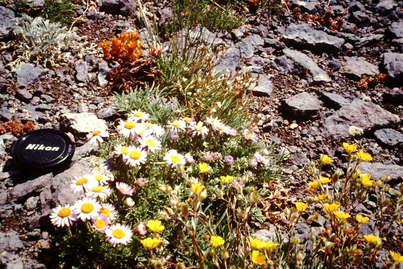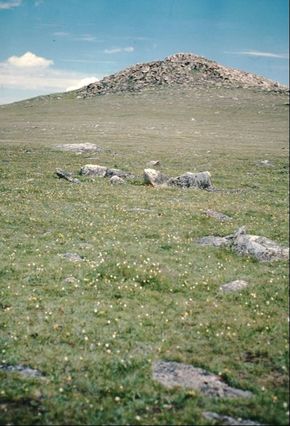Above a series of steep-sided alpine valleys stands a broad, rolling upland bare of trees, extending over to the rim of the next valley. Several feet beneath the ground surface is permafrost: soil and rock saturated with year-round ice. The top portion of the soil thaws in the summer, supporting short-grass turf mixed in with other dwarf vegetation among scattered stones. In some places the turf is interrupted by lines or networks of trenches filled with loose rocks and boulders.
Dimensions The highland surface extends thousands of feet (hundreds of meters) from rim to rim, gently rising and falling by tens of feet (several meters). Where they exist, the boulder trenches are a few feet (1 m) to a few yards (meters) across. (A schematic map showing an example network of rock-filled trenches, tundra turf areas (blank), and largest turf-surface boulders, is available for download on the FOR GAME MASTERS page.)
Key Details
- The edge of the upland is quite distinct, with easy walking conditions above, and climbing or serious scrambling required below. In some places, the highland rim is a bedrock precipice. The view can be spectacular out over steep-sided, concave-bottomed trough valleys hundreds or thousands of feet below, with the chance to look down on clouds or eagles in flight. However the tundra surface may gradually steepen as it nears the sudden drop-off, increasing the chance that a stumble and roll will have disastrous consequences.
- For a few weeks in summer, the tundra surface is covered· with wildflowers; bumblebees hum from bloom to bloom.

- In rare places, bedrock has been exposed by the slow downhill flow of wet tundra soils.
- Boulders in the trenches appear jumbled, and have no soil between them (at least as far down as the eye can see). The boulder/stone fill may have the same surface level as surrounding areas of turf, or it may be a foot or two lower. A web-like network of these trenches is more commonly found on near-level ground, while parallel trenches run down any discernable slope.
- In winter, snow will accumulate in drifts just below the upland rim on the downwind side of the broad ridge, and (as the diagram shows) may even give a false perception of the actual limit of solid ground. Some of these drifts may last well into the summer, if the highland rim shields them from direct sun. Their slow melt may be the nearest available source of water.
Story Elements

- Reaching this upland makes a sudden and extreme change in environment, after a hard climb up the valley side. Depending on season and momentary weather, the climber may be presented with a sunny meadow of flowers or a frigid and bleak expanse. On this higher level, a person’s perception of distance shifts, with hundreds of yards visible, instead of the slope face that was immediately before the climber on the valley wall. The scattered, rounded upland hills make navigation difficult, and present long, possibly unexpected treks for travelers attempting to reach a ‘true summit’ or peer down into other nearby valleys.
- This place offers few apparent resources to a traveler. Water is scarce, likely limited to rainwater puddles in shallow basins on rocks. Wildlife includes some rodents, including weasel-sized marmots. Rarely, a herd of elk will pass through on the way to pastures in distant valleys.
- In storms, lightning strikes will be common here. A standing figure on an otherwise featureless rise will serve very well as a lightning rod. In this region, July and August weather, even on otherwise clear, perfect days, often includes a late afternoon thunderstorm. Local characters/experienced travelers will be better able to predict these changes and find safer ground.
- An ice-glazed snow surface following sunny days will be slick, so that even gentle slopes threaten a long slide down to the upland rim. Scattered exposed boulder tops may provide secure handholds, or a tumble into a partly-cleared boulder trench could provide a dubious rescue.
- Characters with a need to be at high elevation (to communicate with their satellite, to speak with a cloud deity) might choose to visit this broad tundra.
- Characters can safely watch things occurring far away on other uplands beyond the valleys. Alternatively, it would be an excellent spot to sit on a lichen-covered rock and contemplate infinite distance.
- A boulder trench could hide a campfire or a person. Permafrost limits how much rain the ground absorbs – trenches could fill during heavy rain.
- Artifacts (treasure, dwellings, monuments) left in the past might be upended, moved or buried by slowing flowing tundra soil.
- Combat dynamics:
- The upland edge provides a natural defense line against enemies ascending from below. For groups further above or below the edge, this sharp horizon is a place where large numbers of foes can suddenly appear.
- Falling onto or into a boulder trench may lead to severe injury. Anyone in the trench must cope with very uneven footing and the possibility of having a limb wedged down into a space between boulders.
- The upland edge provides a natural defense line against enemies ascending from below. For groups further above or below the edge, this sharp horizon is a place where large numbers of foes can suddenly appear.
Reference Location
Rolling uplands of Rocky Mountain National Park, north-central Colorado. Nearby, within five miles (8 km) are alpine valleys and valley-head cirques (see the Cirque and Alpine Valley scene descriptions).
© Rice-Snows 2017
Proudly powered by Weebly






